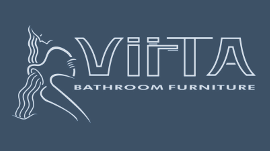
Choosing the flooring for your bathroom is far different than choosing it for any other room in the house. Once you get past durability, style, and cost, you still have one very important factor to consider: large amounts of water!
Water is everywhere in your bathroom and will quickly ruin the wrong flooring. With that in mind, here are some flooring options to consider (best to worst):
1. Porcelain or Ceramic Tile
Porcelain tile is the best of all worlds for bathroom flooring: waterproof, stylish, and cost-effective.
Advantages
With so many different types and styles, you can create the exact floor your dreaming of. You can even find ceramic tile that looks like wood or stone.
Individual tile comes in a wide variety of size and shapes, from square and rectangular to octagonal and hexagonal. Smaller mosaic tiles are pre-mounted on plastic mesh sheets, so you do not have to individually set each tile. With tinted grout, you can be even more creative.
Best of all, tile cleans up well and bravely resists even standing pools of water.
Disadvantages
Like stone, tile is cold. As a solution, radiant or heated tiles can be laid underneath.
Wet tile is slippery. Texturing solves that problem. Smaller tiles are less slippery because more grout is used and the grout acts as a non-skid surface.
2. Vinyl Sheet, Plank, or Tile
With reasonable good looks and supreme practicality, vinyl has been a popular choice for bathroom flooring for decades.
Sheet vinyl flooring is your best option for wet bathrooms, like children's bathrooms or laundry rooms. Vinyl comes in large sizes and therefore can have as few as zero seams in a small bathroom. Luxury vinyl plank flooring, an increasingly popular choice, comes in narrow widths (about 5 inches) and long lengths (up to 48 inches).
Advantages
Most vinyl flooring is very much a do-it-yourself job. Because vinyl is so popular, there are thousands of style options available.
Disadvantages
Gapped and poorly laid seams are floor killers. Vinyl flooring is only as good as its seams.
Sheet vinyl is difficult for the do-it-yourselfer to install.
3. Natural Stone
Natural stone is a good choice for the bathroom, but only if you can afford it. There are few moisture problems with marble, granite, limestone, and the other stone flooring options.
Advantages
Natural stone is hard, durable, and aesthetically pleasing. Stone flooring returns excellent resale value.
Disadvantages
Stone flooring can be cold and slippery. Coldness can be solved by installing radiant heating. The slip factor can be mitigated by having the stone textured with sandblasting or by purchasing naturally textured stone, such as slate.
Real stone flooring is by far your most expensive flooring option.
4. Engineered Wood
Engineered wood is better than solid wood under high moisture conditions due to its dimensional stability.
Advantages
Engineered wood has a plywood base that holds up well against moisture. It looks like authentic wood because the top layer is in fact real wood.
If you want the natural wood look, engineered wood is the best choice.
Disadvantages
Any type of wood product, no matter how well protected, is prone to damage in bathrooms.
5. Laminate Flooring
Surprisingly, laminate flooring is a better bathroom flooring choice than solid hardwood. Laminate flooring is no more than resin-impregnated paper atop a wood chip base. The surface of laminate plank is actually a photograph of oak, cherry, slate, marble, or any other wood or stone. On top is a clear coat called the wear layer, which is amazingly strong.
Advantages
Laminate can work in bathrooms if you take care to protect the wood base from moisture. With tight seams between the planks, it is difficult for moisture to work its way downward.
Laminate is easy to clean.
Disadvantages
Laminate still has a wood chip base. If it comes into contact with moisture, it will expand and bubble, and the only way to fix it is to tear it out.
Truly waterproof laminate flooring is an idea that has not yet come to fruition even though several manufacturers have tried.
The Worst Bathroom Flooring Options
Solid Hardwood
Except for its top coating, solid hardwood has no protection against moisture. Even the smallest amount of moisture that works its way into the wood will eventually rot it out.
Hardwood looks great and feels warm under your feet. If you absolutely do want solid hardwood in your bathroom, make sure it is perfectly installed, with zero gaps for moisture. This means hiring professionals to install. It also means site-finishing your hardwood by flooding the seams between the boards with coating, effectively blocking moisture migration from the top side.
Carpeting
Carpeting retains moisture for quite long and dries out slowly. This makes carpeting a bad (very bad!) flooring choice for bathrooms.
Source: https://www.thespruce.com/top-bathroom-flooring-options-1821353


































